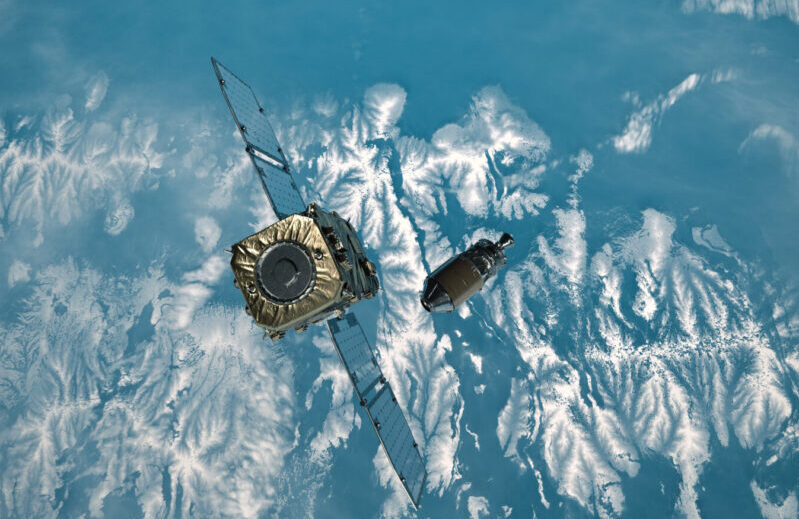26.09.2024
After achieving the world's first close-up imaging of space debris, startup Astroscale aims to move debris into Earth's atmosphere, where it will burn up.

Space debris has been seen as a persistent hazard in outer space, and efforts to remove it are edging closer to commercialization in Japan. On August 19, Astroscale, a startup aiming to become a "space janitor," secured a ¥12 billion JPY (about $83 million USD) contract from the Japan Aerospace Exploration Agency (JAXA) for a demonstration project for its debris removal technology.
This marks the second phase of Astroscale's demonstrations, following the world's first successful close-up imaging of debris. By March 2029, the company plans to capture space debris with a satellite and safely remove it from orbit.
The growing demand for space debris removal offers Japan a significant opportunity to enhance its global competitiveness in the space industry.
What is Space Debris?
Space debris refers to defunct artificial objects, such as decommissioned satellites, discarded rocket stages, and fragments from exploded rockets or satellites. Over 90% of the objects orbiting Earth fall under this classification.
Even small pieces of debris can cause devastating damage if they collide with operational satellites. The increasing number of near-misses has made this a major international concern.
The European Space Agency estimates that there are about 40,000 pieces of debris larger than 10 centimeters (4 inches). When including those over one centimeter, the total exceeds one million. These objects orbit Earth at speeds of around 8 kilometers (5 miles) per second.
If one were to collide with Japan's weather satellite Himawari, it could halt the collection of crucial data, severely affecting weather forecasting.

Phase 1: Close-Up Observations
JAXA is advancing a project to support the commercialization of space debris removal, with Astroscale leading the first phase focused on observation.
In May, an Astroscale satellite, equipped with high-performance cameras and laser rangefinders, approached within 50 meters (164 feet) of an 11-meter-long rocket remnant. This marked the closest approach to space debris ever achieved.
The satellite also conducted a 360-degree survey, gathering valuable data on the debris's movement, deterioration, and exposure to ultraviolet radiation.
Phase 2: Removing Space Debris
The second phase of the demonstration will involve using a robotic arm to capture debris and guide it into Earth's atmosphere, where it will burn up.
This process requires accurately estimating the location of fast-moving, uncontrolled debris and safely maneuvering the satellite close enough to capture it. The sequence of tasks demands highly advanced and complex technology.
Astroscale plans to use insights from its debris observation efforts to further refine its robotic arm for debris capture. Successful debris removal would accelerate its goal of launching a full-scale space debris removal service by 2030. The ¥12 billion contract is the largest in the company's history.
Following the August 19 announcement, the stock price of its parent company Astroscale Holdings (HD) led by President and CEO Mitsunobu Okada briefly returned to ¥1,000, reflecting strong investor confidence.
The Space Janitor of the Future?
Mitsunobu Okada founded Astroscale Group in 2013. He previously worked at Japan's Ministry of Finance and the American consulting firm McKinsey & Company.
Today, the company operates in five countries, including Japan, the United States, and the United Kingdom, with over 70% of its 600 employees being engineers. In June, Astroscale was listed on the Growth Market, a section of the Tokyo Stock Exchange for emerging companies.
Okada has warned, "If we do not take action, space will become so cluttered with debris that it will no longer be physically possible to use it sustainably."
Furthermore, Astroscale plans to expand its business to on-orbit services. These will include satellite refueling and orbit adjustments, offering comprehensive "space aftercare."
Growth of On-Orbit Services
With the increasing use of satellites for communication and weather observation, the number of satellites (currently around 10,000) is expected to exceed 20,000 by 2030. As a result, the on-orbit services sector is projected to grow rapidly.
According to data from an American research firm published by Astroscale HD, the cumulative market size for on-orbit services from 2023 to 2033 is projected to reach $18.2 billion. Astroscale HD aims to secure over 50% of this market share. CEO Okada confidently stated, "Our company is at the forefront of the world."
There is increasing support for international regulations on space debris removal, including making countries accountable for the debris they generate. Establishing rules for mandatory debris removal could significantly accelerate commercialization efforts.
Companies worldwide also entering the market with these potential regulations in mind. In Japan, another startup is developing laser technology to shoot debris into the atmosphere.
Although Japan has historically lagged behind the US and Russia in space development, there is increasing optimism that it could become a leader in the emerging field of space debris removal.
Quelle: JAPAN Forward
